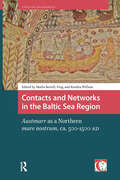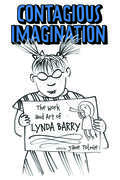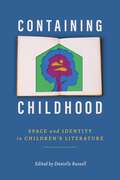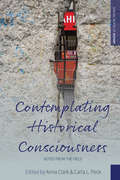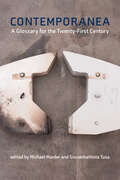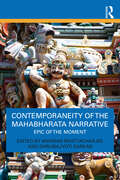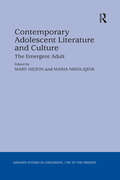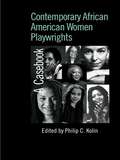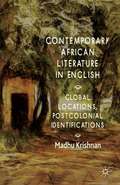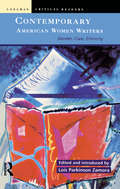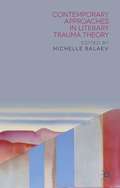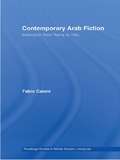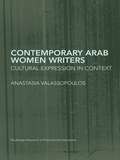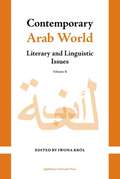- Table View
- List View
Contacts and Networks in the Baltic Sea Region: Austmarr as a Northern mare nostrum, ca. 500-1500 AD (Crossing Boundaries: Turku Medieval and Early Modern Studies)
by Maths Bertell Frog Kendra WillsonSince prehistoric times, the Baltic Sea has functioned as a northern mare nostrum — a crucial nexus that has shaped the languages, folklore, religions, literature, technology, and identities of the Germanic, Finnic, Sámi, Baltic, and Slavic peoples. This anthology explores the networks among those peoples. The contributions to Contacts and Networks in the Baltic Sea Region: Austmarr as a Northern mare nostrum, ca. 500-1500 ad address different aspects of cultural contacts around and across the Baltic from the perspectives of history, archaeology, linguistics, literary studies, religious studies, and folklore. The introduction offers a general overview of crosscultural contacts in the Baltic Sea region as a framework for contextualizing the volume's twelve chapters, organized in four sections. The first section concerns geographical conceptions as revealed in Old Norse and in classical texts through place names, terms of direction, and geographical descriptions. The second section discusses the movement of cultural goods and persons in connection with elite mobility, the slave trade, and rune-carving practice. The third section turns to the history of language contacts and influences, using examples of Finnic names in runic inscriptions and Low German loanwords in Finnish. The final section analyzes intercultural connections related to mythology and religion spanning Baltic, Finnic, Germanic, and Sámi cultures. Together these diverse articles present a dynamic picture of this distinctive part of the world.
Contagion Narratives: The Society, Culture and Ecology of the Global South (Routledge Studies in World Literatures and the Environment)
by R. Sreejith Varma Ajanta SircarThis volume is a collection of ten essays that direct their gaze to the unfolding of contagions in the non-classical contexts of Asia and Africa. Or, to borrow from the title of one of Partha Chatterjee’s books, they are reflections on the pandemic in most of the world. Featuring many scholars (of the humanities and social sciences) in the Global South, these chapters take as their intellectual focus the political-social as well as the ethical challenges posed by the contagions in the "East." Through analyses of literary narratives/films/video games, this Contagion Narratives traces the manufactured narratives of victimization by majority-communities and the lethal divides consequently being drawn between a reconstituted "authentic majority" and the more vulnerable minority ‘other’ in these societies. The essays in this collection are animated by imaginations of liveable alternatives on a planet on the brink. This volume traces lineages to Buchi Emecheta and Rabindranath Tagore rather than Albert Camus, to Satyajit Ray and the indie traditions rather than Hollywood, and to Buddhism rather than Christianity, to track the historic journeys of "modernity." Using an eclectic set of analytical tools and strategies of textual criticism, this volume argues that ideas of "democracy," even while they carry echoes of other societies, are markedly different as they travel from Gaddafi’s Libya to Wuhan under lockdown to colonial Bengal.
Contagion and the Shakespearean Stage (Palgrave Studies in Literature, Science and Medicine)
by Mary Floyd-Wilson Darryl ChalkThis collection of essays considers what constituted contagion in the minds of early moderns in the absence of modern germ theory. In a wide range of essays focused on early modern drama and the culture of theater, contributors explore how ideas of contagion not only inform representations of the senses (such as smell and touch) and emotions (such as disgust, pity, and shame) but also shape how people understood belief, narrative, and political agency. Epidemic thinking was not limited to medical inquiry or the narrow study of a particular disease. Shakespeare, Thomas Middleton, Ben Jonson, Thomas Dekker and other early modern writers understood that someone might be infected or transformed by the presence of others, through various kinds of exchange, or if exposed to certain ideas, practices, or environmental conditions. The discourse and concept of contagion provides a lens for understanding early modern theatrical performance, dramatic plots, and theater-going itself.
Contagion, Hygiene, and the European Avant-Garde (Routledge Research in Art History)
by David Hopkins Disa PerssonThis interdisciplinary collection of essays brings together scholars in the fields of art history, theatre, visual culture, and literature to explore intersections between the European avant-garde (c. 1880–1945) and themes of health and hygiene, such as illness, contagion, cleanliness, and contamination. Examining the artistic oeuvres of some of the canonical names of modern art – including Edgar Degas, Edvard Munch, Pablo Picasso, George Orwell, Marcel Duchamp, and Antonin Artaud – this book investigates instances where the heightened political, social, and cultural currencies embedded within issues of hygiene and contagion have been mobilised, and subversively exploited, to fuel the critical strategy at play. This edited volume promotes an interdisciplinary and socio-historically contextualised understanding of the criticality of the avant-garde gesture and cultivates scholarship that moves beyond the limits of traditional academic subjects to produce innovative and thought-provoking connections and interrelations across various fields. The book will be of interest to scholars working in art history, literature, theatre, cultural studies, modern history, medical humanities, and visual culture.
Contagious Imagination: The Work and Art of Lynda Barry (Critical Approaches to Comics Artists Series)
by Glenn WillmottContributions by Frederick Luis Aldama, Melissa Burgess, Susan Kirtley, Rachel Luria, Ursula Murray Husted, Mark O’Connor, Allan Pero, Davida Pines, Tara Prescott-Johnson, Jane Tolmie, Rachel Trousdale, Elaine Claire Villacorta, and Glenn WillmottLynda Barry (b. 1956) is best known for her distinctive style and unique voice, first popularized in her underground weekly comic Ernie Pook’s Comeek. Since then, she has published prolifically, including numerous comics, illustrated novels, and nonfiction books exploring the creative process. Barry’s work is genre- and form-bending, often using collage to create what she calls “word with drawing” vignettes. Her art, imaginative and self-reflective, allows her to discuss gender, race, relationships, memory, and her personal, everyday lived experience. It is through this experience that Barry examines the creative process and offers to readers ways to record and examine their own lives. The essays in Contagious Imagination: The Work and Art of Lynda Barry, edited by Jane Tolmie, study the pedagogy of Barry’s work and its application academically and practically. Examining Barry’s career and work from the point of view of research-creation, Contagious Imagination applies Barry’s unique mixture of teaching, art, learning, and creativity to the very form of the volume, exploring Barry’s imaginative praxis and offering readers their own. With a foreword by Frederick Luis Aldama and an afterword by Glenn Willmott, this volume explores the impact of Barry’s work in and out of the classroom. Divided into four sections—Teaching and Learning, which focuses on critical pedagogy; Comics and Autobiography, which targets various practices of rememorying; Cruddy, a self-explanatory category that offers two extraordinary critical interventions into Barry criticism around a challenging text; and Research-Creation, which offers two creative, synthetic artistic pieces that embody and enact Barry’s own mixed academic and creative investments—this book offers numerous inroads into Barry’s idiosyncratic imagination and what it can teach us about ourselves.
Containing Childhood: Space and Identity in Children’s Literature (Children's Literature Association Series)
by Danielle RussellContributions by Miranda A. Green-Barteet, Kathleen Kellett, Andrew McInnes, Joyce McPherson, Rebecca Mills, Cristina Rivera, Wendy Rountree, Danielle Russell, Anah-Jayne Samuelson, Sonya Sawyer Fritz, Andrew Trevarrow, and Richardine Woodall Home. School. Nature. The spaces children occupy, both physically and imaginatively, are never neutral. Instead, they carry social, cultural, and political histories that impose—or attempt to impose—behavioral expectations. Moreover, the spaces identified with childhood reflect and reveal adult expectations of where children “belong.” The essays in Containing Childhood: Space and Identity in Children’s Literature explore the multifaceted and dynamic nature of space, as well as the relationship between space and identity in children’s literature. Contributors to the volume address such questions as: What is the nature of that relationship? What happens to the spaces associated with childhood over time? How do children conceptualize and lay claim to their own spaces? The book features essays on popular and lesser-known children’s fiction from North America and Great Britain, including works like The Hate U Give, His Dark Materials, The Giver quartet, and Shadowshaper. Adopting a multidisciplinary approach in their analysis, contributors draw upon varied scholarly areas such as philosophy, race, class, and gender studies, among others. Without reducing the issues to any singular theory or perspective, each piece provides insight into specific treatments of space in specific periods of time, thereby affording scholars a greater appreciation of the diverse spatial patterns in children’s literature.
Contaminations and Ethnographic Fictions: Southern Crossings (Palgrave Studies in Literary Anthropology)
by Oscar HemerIn an unusual merging of academic and literary practices, this volume attempts to identify a form (or forms) that is congenial with the subject of interrogation: the world in transition, with South Africa as the main focal point. Approaching anthropology from the position of the literary writer, Oscar Hemer here takes the reader through a kaleidoscope of perspectives—a stream-of-consciousness understanding of “writing the city” of Johannesburg, embedding ethnography in subjectivity; a challenge to binaries both temporal and gendered in examining the growth of the IT metropolis Bangalore to a combusting mega-city; an auto-ethnographic interweaving of fictional reportage with a close-reading of anthropological and philosophical treatises, including Mary Douglas’s Purity and Danger and Edouard Glissant’s Poetics of Relation, among others—to interrogate themes of transition, identity, purity and variation in the Western Cape. As the form transcends boundaries to create a methodological hybrid, creolization comes to the fore as a theoretical concept and as cultural practice.
Contemplating Historical Consciousness: Notes from the Field (Making Sense of History #36)
by Anna Clark Carla L. PeckThe last several decades have witnessed an explosion of new empirical research into representations of the past and the conditions of their production, prompting claims that we have entered a new era in which the past has become more “present” than ever before. Contemplating Historical Consciousness brings together leading historians, ethnographers, and other scholars who give illuminating reflections on the aims, methods, and conceptualization of their own research as well as the successes and failures they have encountered. This rich collective account provides valuable perspectives for current scholars while charting new avenues for future research.
Contemplative and Artful Openings: Researching Women and Teaching (Routledge Research in Education #193)
by Susan Casey WalshHighlighting an arts-based inquiry process that involves contemplation, mindful awareness, and artful writing, this book explores women’s difficult experiences in teaching. It weaves a strong autobiographical thread with artifacts from several research projects with female teachers. By linking innovative approaches to research that involve visual images and poetic writing with feminist poststructuralist theories and Buddhist-inspired practices, Walsh offers new understandings about what it means to be critical in research and teaching—and also what transformation, both social and personal, might entail.
Contemporanea: A Glossary for the Twenty-First Century
by Michael Marder Giovanbattista TusaA groundbreaking, multidisciplinary collection that rethinks our present moment and anticipates the key concepts that will shape and direct the twenty-first century.Contemporanea is a nascent lexicon for the twenty-first century edited by seasoned philosophers and authors Michael Marder and Giovanbattista Tusa. The collection showcases perspectives from a range of noteworthy thinkers in philosophy, ecology, and cultural studies, as well as artists, from across the globe, including Slavoj Zizek, Timothy Morton, Denise Ferreira Da Silva, and Vandana Shiva, who each describe what they anticipate will be the concepts shaping the trajectory of this century—everything from the world state to the nuclear taboo, automation to Teslaism, plant sexuality to arachnomancy, and ecotrauma to resonances, to name a few.This century, as the editors explain, has to date grounded itself in the debris of the preceding century, whose revolutions and struggles failed to transform our time: post-colonialism, post-fascism, and post-liberalism have morphed into neocolonialism, neoliberalism, and neofascism, often combined in a previously unimaginable mix. And, just as the political developments at the beginning of the twenty-first century revived and reshuffled those of the preceding epoch, so too have philosophical trends sought to breathe fresh life into the stillborn -isms of the past—realism, vitalism, logicism, materialism, empiricism, criticism—adding the adjective &“new&” and sometimes &“radical&” before them. To articulate a different future, another language is needed. And, to develop another language, one needs to develop fresh concepts, including the concepts proposed in this collection.ContributorsMieke Bal, Claudia Baracchi, Amanda Boetzkes, Erik Bordeleau, Anita Chari, Emanuele Coccia, Valentina Desideri, Roberto Esposito, Filipe Ferreira, Denise Ferreira da Silva, Claire Fontaine, Graham Harman, Yogi Hale Hendlin, Ranjit Hoskote, Cymene Howe, Daniel Innerarity, Joela Jacobs, Ken Kawashima, Sabu Kohso, Bogna Konior, Brandon LaBelle, Anna Longo, Artemy Magun, Michael Marder, Michael Marder, Jason Bahbak Mohaghegh, Timothy Morton, Mycelium, Jean-Luc Nancy, Bahar Noorizadeh, Kelly Oliver, Uriel Orlow, Richard Polt, Marcia Sá Cavalcante Schuback, Tomás Saraceno, Vandana Shiva, Anton Tarasyuk, Anaïs Tondeur, Giovanbattista Tusa, Sjoerd van Tuinen, Santiago Zabala, Zahi Zalloua, Slavoj Žižek
Contemporaneity of the Mahabharata Narrative: Epic of the Moment
by Anirban Bhattacharjee and Dhrubajyoti SarkarNotwithstanding its renowned comprehensive narrative encapsulation of the Indic culture, the Mahabharata keeps on posing a challenge to its contemporary readers: how do we relate to something over two-millennia old in today’s context without freezing it in time? This volume looks at the problem from diverse periods and standpoints and shows us that this challenge is, in fact, a legacy of the Mahabharata and the responses to this challenge are what makes the text ever-contemporary to different readers of different times and positions.It traces the evolution of the Mahabharata from its inception in the fifth century BCE to twenty-first century, spanning classical Sanskrit tradition, Persian and Bengali adaptations, the Mahabharata as a serialized TV show to more recent graphic narratives. By attempting to analyse this diversity, this volume further delves into how the issues in the Mahabharata resonate across time, from the world of ancient sages to contemporary struggles of women. The essays in this book adopt a dual perspective to appreciate both the Mahabharata’s historical context, its exploration of war, heroes and heroines, gender, psychology, philosophy, and its implications for the future.This book will be of interest to scholars and researchers of Indian literature, ancient literature and philosophy, English literature, cultural studies, visual studies, gender studies, and translation studies.
Contemporary Adolescent Literature and Culture: The Emergent Adult (Studies in Childhood, 1700 to the Present)
by Mary Hilton Maria NikolajevaOffering a wide range of critical perspectives, this volume explores the moral, ideological and literary landscapes in fiction and other cultural productions aimed at young adults. Topics examined are adolescence and the natural world, nationhood and identity, the mapping of sexual awakening onto postcolonial awareness, hybridity and trans-racial romance, transgressive sexuality, the sexually abused adolescent body, music as a code for identity formation, representations of adolescent emotion, and what neuroscience research tells us about young adult readers, writers, and young artists. Throughout, the volume explores the ways writers configure their adolescent protagonists as awkward, alienated, rebellious and unhappy, so that the figure of the young adult becomes a symbol of wider political and societal concerns. Examining in depth significant contemporary novels, including those by Julia Alvarez, Stephenie Meyer, Tamora Pierce, Malorie Blackman and Meg Rosoff, among others, Contemporary Adolescent Literature and Culture illuminates the ways in which the cultural constructions 'adolescent' and 'young adult fiction' share some of society's most painful anxieties and contradictions.
Contemporary African American Literature: The Living Canon (Blacks in the Diaspora)
by Lovalerie King and Shirley Moody-TurnerEssays exploring contemporary black fiction and examining important issues in current African American literary studies.In this volume, Lovalerie King and Shirley Moody-Turner have compiled a collection of essays that offer access to some of the most innovative contemporary black fiction while addressing important issues in current African American literary studies. Distinguished scholars Houston Baker, Trudier Harris, Darryl Dickson-Carr, and Maryemma Graham join writers and younger scholars to explore the work of Toni Morrison, Edward P. Jones, Trey Ellis, Paul Beatty, Mat Johnson, Kyle Baker, Danzy Senna, Nikki Turner, and many others. The collection is bracketed by a foreword by novelist and graphic artist Mat Johnson, one of the most exciting and innovative contemporary African American writers, and an afterword by Alice Randall, author of the controversial parody The Wind Done Gone. Together, King and Moody-Turner make the case that diversity, innovation, and canon expansion are essential to maintaining the vitality of African American literary studies.“A compelling collection of essays on the ongoing relevance of African American literature to our collective understanding of American history, society, and culture. Featuring a wide array of writers from all corners of the literary academy, the book will have national appeal and offer strategies for teaching African American literature in colleges and universities across the country.” —Gene Jarrett, Boston University“[This book describes] a fruitful tension that brings scholars of major reputation together with newly emerging critics to explore the full range of literary activities that have flourished in the post-Civil Rights era. Notable are such popular influences as hip-hop music and Oprah Winfrey’s Book Club.” —American Literary Scholarship, 2013
Contemporary African American Women Playwrights: A Casebook (Casebooks on Modern Dramatists)
by Philip C. Kolin'The impressive array of scholars gathered in this collection, all experts in the field, read the plays with nuance and situate them deftly within their cultural and historical contexts. Scholars of contemporary theater and drama and of African American literature will find value in this engaging collection.' – Choice 'For students and scholars of American theatre and drama generally and African American theatre and drama most particularly, this is an extremely valuable critical source.' – Harry Elam, Stanford University, USA In the last fifty years, American and World theatre has been challenged and enriched by the rise to prominence of numerous female African American dramatists. Contemporary African American Women Playwrights is the first critical volume to explore the contexts and influences of these writers, and their exploration of black history and identity through a wealth of diverse, courageous and visionary dramas. Kolin compiles a wealth of new essays, comprising: Yale scholar David Krasner on the dramatic legacy of Lorraine Hansberry, Zora Neale Hurston, Marita Bonner and Georgia Douglas Johnson individual chapters devoted to: Alice Childress, Sonia Sanchez, Adrienne Kennedy, Ntozake Shange, Pearl Cleage, Aishah Rahman, Glenda Dickerson, Anna Deavere Smith and Suzan Lori-Parks an essay and accompanying interview with Lynn Nottage comprehensive discussion of attendant theatrical forms, from choreopoems and surrealistic plays, to documentary theatre and civil rights dramas, and their use in challenging racial and gender hierarchies. Contributors: Brandi Wilkins Catanese, Soyica Diggs, James Fisher, Freda Scott Giles, Joan Wylie Hall, Philip C. Kolin, David Krasner, Sandra G. Shannon, Debby Thompson, Beth Turner and Jacqueline Wood.
Contemporary African Literature and the Politics of Gender
by Florence StrattonThe influence of colonialism and race on the development of African literature has been the subject of a number of studies. The effect of patriarchy and gender, however, and indeed the contributions of African women, have up until now been largely ignored by the critics. Contemporary African Literature and the Politics of Gender is the first extensive account of African literature from a feminist perspective.In this first radical and exciting work Florence Stratton outlines the features of an emerging female tradition in African fiction. A chapter is dedicated to each to the works of four women writers: Grace Ogot, Flora Nwapa, Buchi Emecheta and Mariama Ba. In addition she provides challenging new readings of canonical male authors such as Chinua Achebe, Ngugi wa Thiongo'o and Wole Soyinka. Contemporary African Literature and the Politics of Gender thus provides the first truly comprehensive definition of the current literary tradition in Africa.
Contemporary African Literature in English
by Madhu KrishnanContemporary African Literature in English explores the contours of representation in contemporary Anglophone African literature, drawing on a wide range of authors including Chimamanda Ngozi Adichie, Aminatta Forna, Brian Chikwava, Ngug? wa Thiong'o, Nuruddin Farah and Chris Abani.
Contemporary American Fiction in the European Classroom: Teaching and Texts
by Laurence W. Mazzeno Sue NortonThis book offers insight into the ways students enrolled in European classrooms in higher education come to understand American experience through its literary fiction, which for decades has been a key component of English department offerings and American Studies curricula across the continent and in Great Britain and Ireland. The essays provide an understanding of how post-World War II American writers, some already elevated to ‘canonical status’ and some not, are represented in European university classrooms and why they have been chosen for inclusion in coursework. The book will be of interest to scholars and teachers of American literature and American studies, and to students in American literature and American studies courses.
Contemporary American Literature and Excremental Culture: American Sh*t (American Literature Readings in the 21st Century)
by Mary C. FoltzContemporary American Literature and Excremental Culture: American Sh*t analyzes post-1960 scatological novels that utilize representations of human waste to address pressing issues, including pollution of waterways, environmental racism, and militarism. Primarily examining postmodern parody, the book shows the value of aesthetic renderings of sanitary engineering for composting ideologies that fuel a ruinous impact on the world. Drawing on late twentieth-century psychoanalytic thinkers Norman O. Brown, Frantz Fanon, and Leo Bersani, American Sh*t shows the continued relevance of psychoanalytic interpretations of contemporary fiction for understanding post-45 authors’ engagement with waste. Ultimately, the monograph reveals how novelists Ishmael Reed, Jonathan Franzen, Gloria Naylor, Don DeLillo, and Samuel R. Delany critique subjects who abnegate their status as waste-producing beings and bring readers back to embraceWinner of the 2019 Northeast Modern Language Association Book Award for Literary Criticism of English Language Literature
Contemporary American Memoirs in Action: How to Do Things with Memoir (American Literature Readings in the 21st Century)
by Jane DanielewiczThis book analyzes a collection of literary memoirs to demonstrate how this genre is an avenue for participation in public life. Writers are repurposing the memoir, a genre known for its personal and expressive function, to engage in debate and serve political goals. The chapters provide case studies for memoir as social action that effects change by looking at the writing of Joan Didion, John Edgar Wideman, James McBride, M. Elaine Mar, Janisse Ray, Lucy Grealy, and Ann Patchett. Drawing on theories of genre and agency, Danielewicz asserts how these writers are acting pragmatically. Memoirs contribute to democratic society by offering solutions, creating new knowledge, revealing social trends, bringing issues to light, creating empathy and connection, and changing public opinion.
Contemporary American Women Writers: Gender, Class, Ethnicity (Longman Critical Readers)
by Lois Parkinson ZamoraThis collection brings together critical essays that examine questions of identity and community in the fiction of contemporary American women writers among them Alice Walker, Toni Morrison and Sandra Cisnernos. The essays consider how identities and societies are dramatized in particular works of fiction, and how these works reflect cultural communities outside the fictional frame - often the communities in which their authors live and work. The essays included here concern fictional representations of African American, Latino, Asian American, Native American, Anglo and Euro-American communities and their working interactions in the multicultural United States. Each critic asks, in his or her own way, how a particular writer transforms her social grounding into language and literature.The introduction includes an overview of the range of literary criticism devoted to contemporary American women writers, and an extensive bibliography of complementary critical readings is provided to encourage further study. Undergraduate and postgraduate students of contemporary literature will find the text an invaluable guide to contemporary women's writing in America, and the range of criticism that this has given rise to.
Contemporary Approaches in Literary Trauma Theory
by Michelle BalaevThis edited collection argues that trauma in literature must be read through a theoretical pluralism that allows for an understanding of trauma's variable representations that include yet move beyond the concept of trauma as pathological and unspeakable.
Contemporary Arab Fiction: Innovation from Rama to Yalu (Routledge Studies in Middle Eastern Literatures)
by Fabio CaianiThis book introduces Western readers to some of the most significant novels written in Arabic since 1979. Despite their contribution to the development of contemporary Arabic fiction, these authors remain largely unknown to non-Arab readers. Fabio Caiani examines the work of the Moroccan Muhammad Barrada; the Egyptian Idwar al-Kharrat; the Lebanese Ilyas Khuri and the Iraqi Fu’ad al-Takarli. Their most significant novels were published between 1979 and 2002, a period during which their work reached literary maturity. They all represent pioneering literary trends compared to the novelistic form canonized in the influential early works of Naguib Mahfouz. Until now, some of their most innovative works have not been analyzed in detail – this book fills that gap. Relying on literary theory and referring to comparative examples from other literatures, this study places its findings within a wider framework, defining what is meant by innovation in the Arabic novel, and the particular socio-political context in which it appears. This book will significantly enrich the existing critical literature in English on the contemporary Arabic novel.
Contemporary Arab Thought: Cultural Critique in Comparative Perspective
by Elizabeth Suzanne KassabDuring the second half of the twentieth century, the Arab intellectual and political scene polarized between a search for totalizing doctrines—nationalist, Marxist, and religious—and radical critique. Arab thinkers were reacting to the disenchanting experience of postindependence Arab states, as well as to authoritarianism, intolerance, and failed development. They were also responding to successive defeats by Israel, humiliation, and injustice. The first book to take stock of these critical responses, this volume illuminates the relationship between cultural and political critique in the work of major Arab thinkers, and it connects Arab debates on cultural malaise, identity, and authenticity to the postcolonial issues of Latin America and Africa, revealing the shared struggles of different regions and various Arab concerns.
Contemporary Arab Women Writers: Cultural Expression in Context (Routledge Research in Postcolonial Literatures)
by Anastasia ValassopoulosThis book engages with contemporary Arab women writers from Egypt, Palestine, Lebanon and Algeria. In spite of Edward Said’s groundbreaking reappraisal of the uneven relationship between the West and the Arab world in Orientalism, there has been little postcolonial criticism of Arab writing. Anastasia Valassopoulos raises the profile of Arab women writers by examining how they negotiate contexts and experiences that have come to be identified with postcoloniality such as the preoccupation with Western feminism, political conflict and war, the social effects of non-conformity and female empowerment, and the negotiation of influential cultural discourses such as orientalism. Contemporary Arab Women Writers revitalizes theoretical concepts associated with feminism, gender studies and cultural studies, and explores how art history, popular culture, translation studies, psychoanalysis and news media all offer productive ways to associate with Arab women’s writing that work beyond a limiting socio-historical context. Discussing the writings of authors including Ahdaf Soueif, Nawal El Saadawi, Leila Sebbar, Liana Badr and Hanan Al-Shaykh, this book represents a new direction in postcolonial literary criticism that transcends constrictive monothematic approaches.
Contemporary Arab World: Literary and Linguistic Issues, Volume 2 (Contemporary Arab World. Literary and Linguistic Issues)
by Iwona KrólContemporary Arab World: Literary and Linguistic Issues, edited by Iwona Król, is the second volume of the monograph with the same title. It consists of papers written by researchers from the Arabic Department of the Institute of Oriental Studies of the Jagiellonian University in Kraków.The authors, on the base of original texts from broadly understood Arab culture, discuss a number of literary and linguistic issues. Individual chapters are of high academic level, and their subject matters are important from the scientific point of view.Monograph will find readers among specialists from various fields: Arabic and Semitic studies, Polish philology, as well as representatives of literary criticism and general linguistics.
